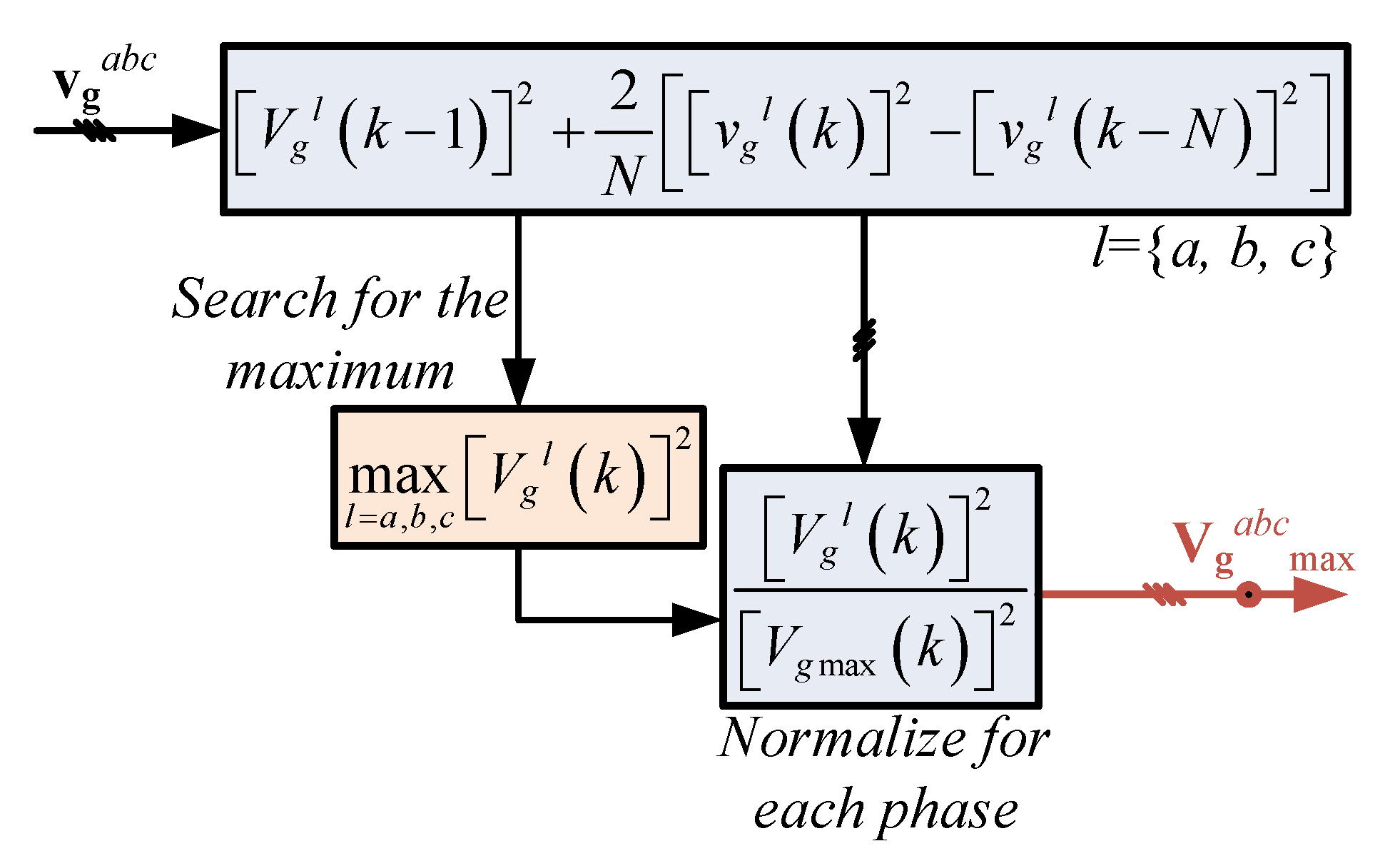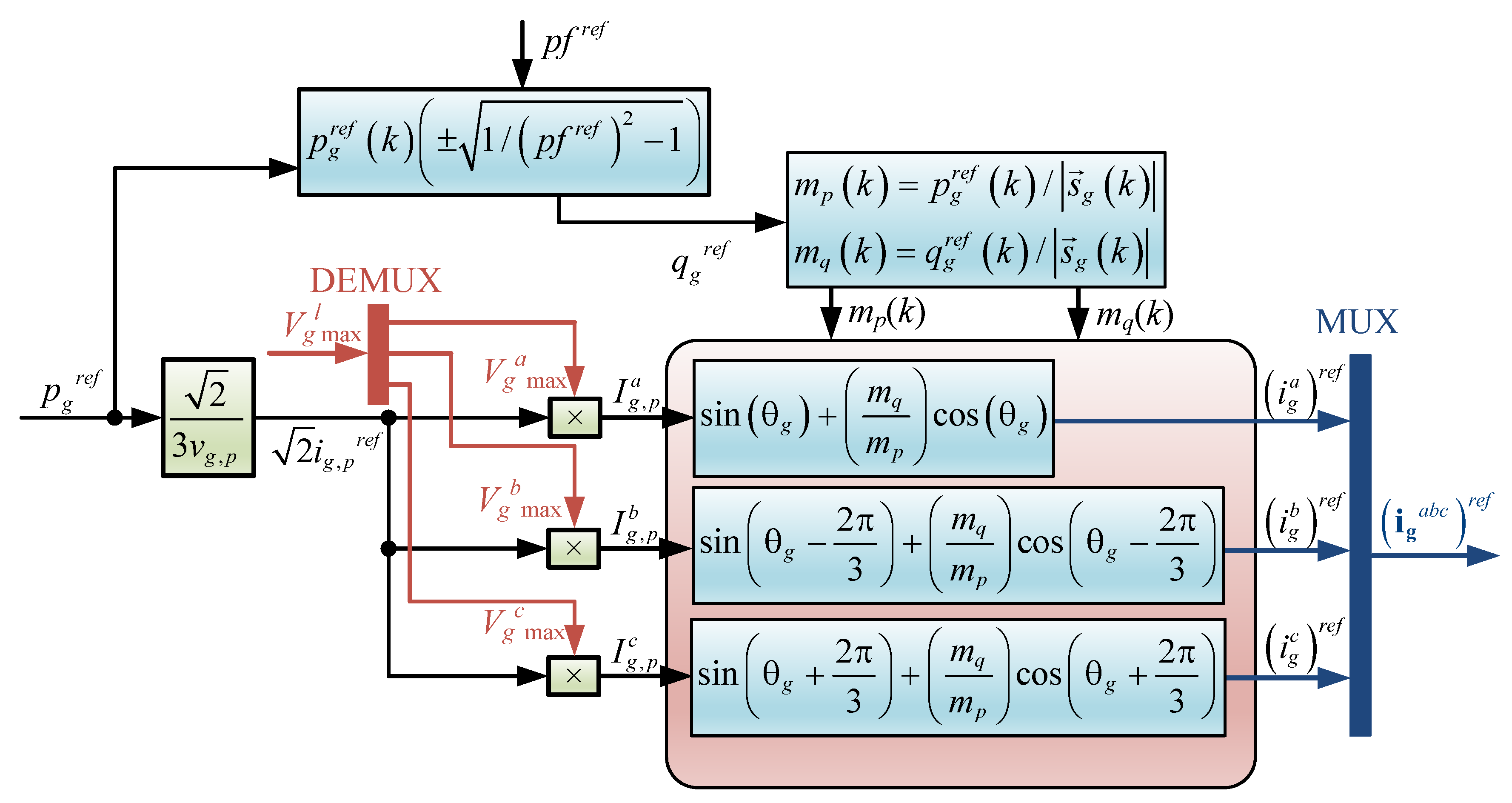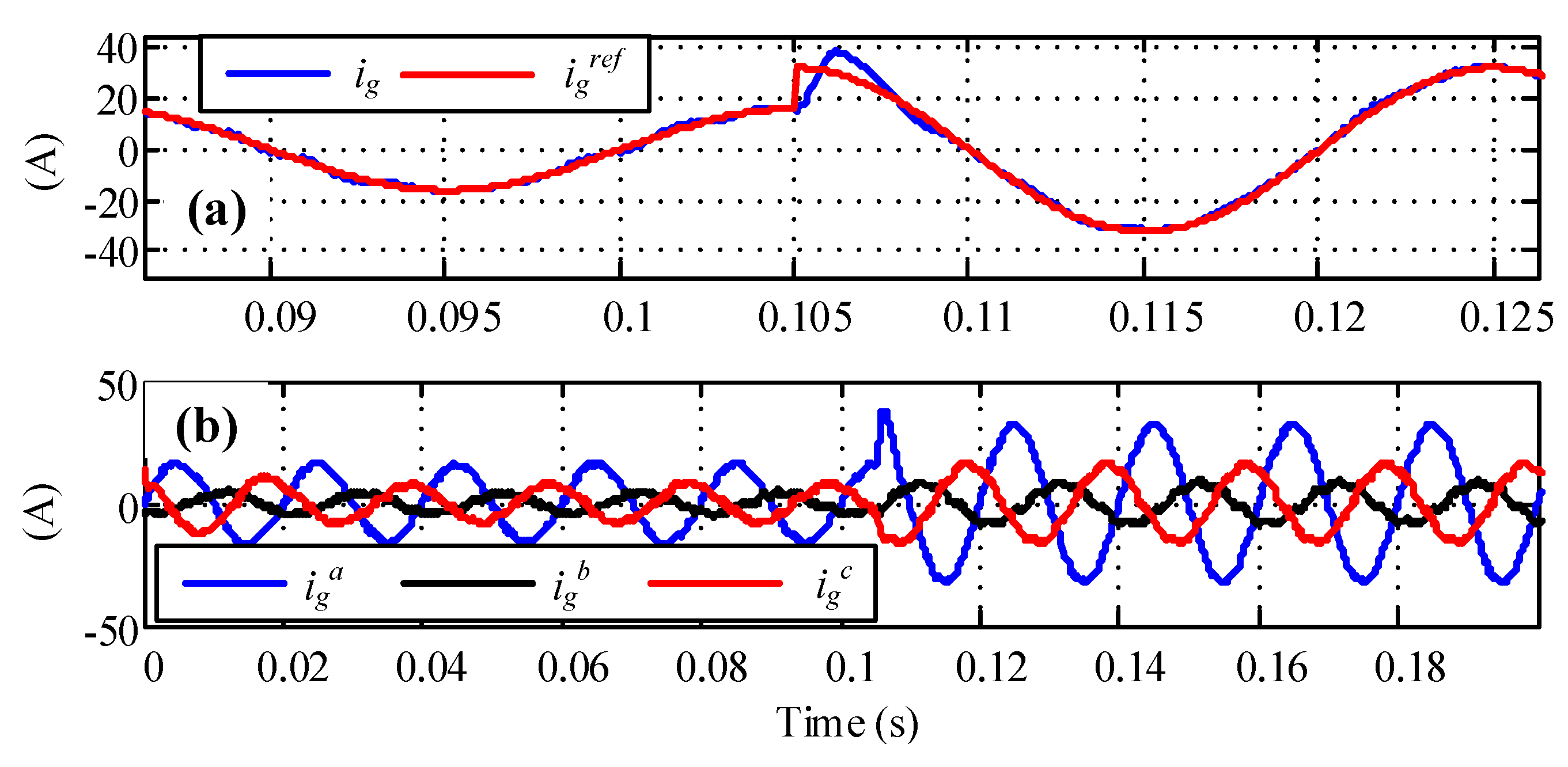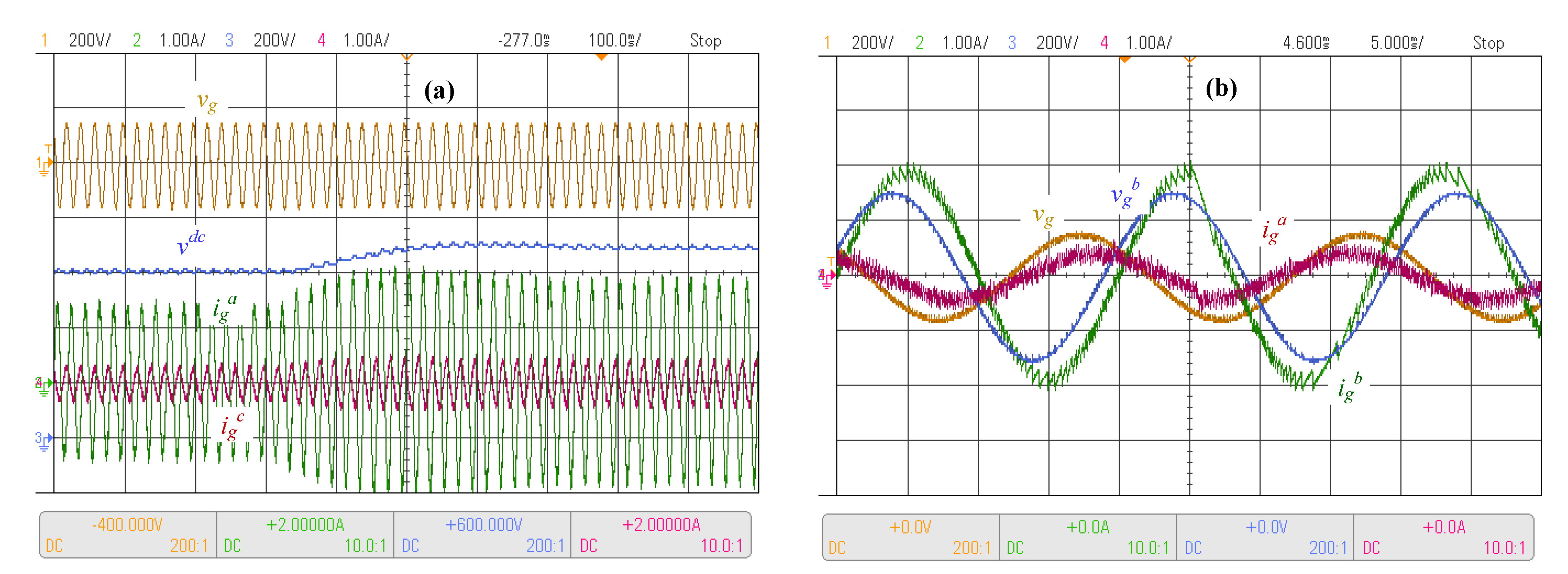Power Converter Resonant Control for an Unbalanced and Non-Constant Frequency Supply
Abstract
:1. Introduction
2. Power Converter Model
3. Power Converter Resonant Control
3.1. Control of the DC Link Voltage
3.2. Rectifier Power Factor Control
3.3. Voltage Amplitude Estimator
3.4. Current References
3.5. Phase Locked Loop (PLL) for Unbalanced Grid Condition
3.6. Resonant Control
4. Pole Locations
Other Unbalanced Current/Voltage Control Techniques and Comparison
5. Results
5.1. Simulation Results
5.2. Experimental Results
6. Conclusions
Author Contributions
Funding
Institutional Review Board Statement
Informed Consent Statement
Data Availability Statement
Acknowledgments
Conflicts of Interest
References
- Islam, R.; Rafin, S.M.S.H.; Mohammed, O.A. Comprehensive Review of Power Electronic Converters in Electric Vehicle Applications. Forecasting 2023, 5, 22–80. [Google Scholar] [CrossRef]
- Darwish, A.; Aggidis, G.A. A Review on Power Electronic Topologies and Control for Wave Energy Converters. Energies 2022, 15, 9174. [Google Scholar] [CrossRef]
- Mohammed, M.F.; Qasim, M.A. Single Phase T-Type Multilevel Inverters for Renewable Energy Systems, Topology, Modulation, and Control Techniques: A Review. Energies 2022, 15, 8720. [Google Scholar] [CrossRef]
- Torres, I.; Muñoz, J.; Rojas, D.; Espinosa, E.E. Selective Harmonic Elimination Technique for a 27-Level Asymmetric Multilevel Converter. Energies 2022, 15, 3694. [Google Scholar] [CrossRef]
- Rohten, J.A.; Silva, J.J.; Muñoz, J.A.; Villarroel, F.A.; Dewar, D.N.; Rivera, M.E.; Espinoza, J.R. A Simple Self-Tuning Resonant Control Approach for Power Converters Connected to Micro-Grids With Distorted Voltage Conditions. IEEE Access 2020, 8, 216018–216028. [Google Scholar] [CrossRef]
- Wei, Y.; Luo, Q.; Mantooth, A. Comprehensive analysis and design of LLC resonant converter with magnetic control. CPSS Trans. Power Electron. Appl. 2019, 4, 265–275. [Google Scholar] [CrossRef]
- Rohten, J.; Villarroel, F.; Pulido, E.; Muñoz, J.; Silva, J.; Perez, M. Stability Analysis of Two Power Converters Control Algorithms Connected to Micro-Grids with Wide Frequency Variation. Sensors 2022, 22, 7078. [Google Scholar] [CrossRef]
- Ma, L.; Zhang, X.; Rao, Y.; Fang, Z.; Rao, Y.; Yang, J. A Robust Model Predictive Control for Multi-microgrids Frequency Control. In Proceedings of the 2020 IEEE 4th Conference on Energy Internet and Energy System Integration (EI2), Wuhan, China, 30 October–1 November 2020; pp. 1637–1641. [Google Scholar] [CrossRef]
- Zhang, Y.; Mou, J.; Zhang, F.; Huang, N. Modeling and Stability Analysis Based on Internal Voltage Dynamics in Synchronverter. Electronics 2023, 12, 700. [Google Scholar] [CrossRef]
- Zanchetta, P.; Degano, M.; Liu, J.; Mattavelli, P. Iterative Learning Control With Variable Sampling Frequency for Current Control of Grid-Connected Converters in Aircraft Power Systems. IEEE Trans. Ind. Appl. 2013, 49, 1548–1555. [Google Scholar] [CrossRef]
- Guo, X.H.; Chang, C.W.; Chang-Chien, L.R. Digital Implementation of Harmonic and Unbalanced Load Compensation for Voltage Source Inverter to Operate in Grid Forming Microgrid. Electronics 2022, 11, 886. [Google Scholar] [CrossRef]
- Krismanto, A.U.; Mithulananthan, N.; Shah, R.; Setiadi, H.; Islam, M.R. Small-Signal Stability and Resonance Perspectives in Microgrid: A Review. Energies 2023, 16, 1017. [Google Scholar] [CrossRef]
- Silva, J.J.; Espinoza, J.R.; Rohten, J.A.; Pulido, E.S.; Villarroel, F.A.; Andreu, M.L. A Novel Simplified Implementation of Finite-Set Model Predictive Control for Power Converters. IEEE Access 2021, 9, 96114–96124. [Google Scholar] [CrossRef]
- Xia, M.; Li, X. Design and Implementation of a High Quality Power Supply Scheme for Distributed Generation in a Micro-Grid. Energies 2013, 6, 4924–4944. [Google Scholar] [CrossRef]
- Mahar, H.; Munir, H.M.; Soomro, J.B.; Akhtar, F.; Hussain, R.; Elnaggar, M.F.; Kamel, S.; Guerrero, J.M. Implementation of ANN Controller Based UPQC Integrated with Microgrid. Mathematics 2022, 10, 1989. [Google Scholar] [CrossRef]
- Sarwar, M.I.; Sarwar, A.; Farooqui, S.A.; Tariq, M.; Fahad, M.; Beig, A.R.; Alamri, B. A Hybrid Nearest Level Combined with PWM Control Strategy: Analysis and Implementation on Cascaded H-Bridge Multilevel Inverter and its Fault Tolerant Topology. IEEE Access 2021, 9, 44266–44282. [Google Scholar] [CrossRef]
- Li, P.; Tong, X.; Wang, Z.; Xu, M.; Zhu, J. Sensorless Model Predictive Control of Single-Phase Inverter for UPS Applications via Accurate Load Current Estimation. Sensors 2023, 23, 3742. [Google Scholar] [CrossRef] [PubMed]
- Han, Q.; Wang, X.; Hu, P.; Wang, M.; Luo, X.; Hou, W. Multi-Mode Voltage Sag/Swell Generator Based on Three-Phase Inverter Circuit. Energies 2021, 14, 6520. [Google Scholar] [CrossRef]
- Liang, C.M.; Lin, Y.J.; Chen, J.Y.; Chen, G.R.; Yang, S.C. Sensorless LC Filter Implementation for Permanent Magnet Machine Drive Using Observer-Based Voltage and Current Estimation. Sensors 2021, 21, 3596. [Google Scholar] [CrossRef]
- Ali, M.; Tariq, M.; Lodi, K.A.; Chakrabortty, R.K.; Ryan, M.J.; Alamri, B.; Bharatiraja, C. Robust ANN-Based Control of Modified PUC-5 Inverter for Solar PV Applications. IEEE Trans. Ind. Appl. 2021, 57, 3863–3876. [Google Scholar] [CrossRef]
- Hao, X.; Wang, Y.; Sun, S.; Jiang, S.; Liu, Y. The Detection Algorithm Based on the Short Time Delay for Three-Phase Unbalanced Voltage Sag. Electronics 2022, 11, 2646. [Google Scholar] [CrossRef]
- Dolado Fernández, J.; Eloy-Garcia, J.; Arnaltes, S.; Rodríguez-Amenedo, J.L. Sequence Control Strategy for Grid-Forming Voltage Source Converters Based on the Virtual-Flux Orientation under Balanced and Unbalanced Faults. Energies 2023, 16, 3056. [Google Scholar] [CrossRef]
- Zhou, S.; Zhang, Y.; Liu, Z.; Liu, J.; Zhou, L. Implementation of Cross-Coupling Terms in Proportional-Resonant Current Control Schemes for Improving Current Tracking Performance. IEEE Trans. Power Electron. 2021, 36, 13248–13260. [Google Scholar] [CrossRef]
- Riedemann, J.; Peña, R.; Blasco-Gimenez, R. A resonant current control of an open-end winding induction motor fed by an indirect matrix converter. In Proceedings of the 2015 IEEE Applied Power Electronics Conference and Exposition (APEC), Charlotte, NC, USA, 15–19 March 2015; pp. 2346–2350. [Google Scholar] [CrossRef]
- Gerez, C.; Coelho Marques Costa, E.; Sguarezi Filho, A.J. Distribution Network Reconfiguration Considering Voltage and Current Unbalance Indexes and Variable Demand Solved through a Selective Bio-Inspired Metaheuristic. Energies 2022, 15, 1686. [Google Scholar] [CrossRef]
- Kenjrawy, H.; Makdisie, C.; Houssamo, I.; Mohammed, N. New Modulation Technique in Smart Grid Interfaced Multilevel UPQC-PV Controlled via Fuzzy Logic Controller. Electronics 2022, 11, 919. [Google Scholar] [CrossRef]
- Jiang, C.; Zhang, S. Power Quality Compensation Strategy of MMC-UPQC Based on Passive Sliding Mode Control. IEEE Access 2023, 11, 3662–3679. [Google Scholar] [CrossRef]
- Marzo, I.; Sanchez-Ruiz, A.; Barrena, J.A.; Abad, G.; Muguruza, I. Power Balancing in Cascaded H-Bridge and Modular Multilevel Converters Under Unbalanced Operation: A Review. IEEE Access 2021, 9, 110525–110543. [Google Scholar] [CrossRef]
- Hu, S.; Liu, G.; Jin, N.; Guo, L. Model Predictive Current Control for Fault-Tolerant Bidirectional Voltage Source Converter with Open Circuit Fault and Unbalanced Grid Voltage. IEEE Access 2020, 8, 154966–154974. [Google Scholar] [CrossRef]
- Alsaif, A.; Miao, Z.; Fan, L. Inner Current Controls of Grid-Connected PV for Unbalanced Grid Conditions. In Proceedings of the 2021 North American Power Symposium (NAPS), College Station, TX, USA, 14–16 November 2021; pp. 1–6. [Google Scholar] [CrossRef]
- Zhang, Y.; Bingyu, L.; Liu, J.; Liu, X. Model-Free Predictive Current Control of PWM Rectifier Under Unbalanced and Distorted Network. In Proceedings of the 2020 IEEE Energy Conversion Congress and Exposition (ECCE), Detroit, MI, USA, 11–15 October 2020; pp. 5944–5951. [Google Scholar] [CrossRef]
- Li, X.; Zhang, C.; Chen, A.; Xing, X.; Zhang, G. Model predictive direct current control strategy for three-level T-type rectifier under unbalanced grid voltage conditions. In Proceedings of the 2018 IEEE Applied Power Electronics Conference and Exposition (APEC), San Antonio, TX, USA, 4–8 March 2018; pp. 1514–1519. [Google Scholar] [CrossRef]
- Ge, J.; Shuai, Z.; Zhao, H.; Shen, Z.J. Generalized Power and Current Control for Three-Phase Four-Wire Converter under Unbalanced Grid Conditions. In Proceedings of the IECON 2019—45th Annual Conference of the IEEE Industrial Electronics Society, Lisbon, Portugal, 14–17 October 2019; Volume 1, pp. 3900–3905. [Google Scholar] [CrossRef]














| Parameter | Value | p.u. or Details |
|---|---|---|
| 220 Vrms | 1 | |
| 750 V | 3.4 | |
| (50 Hz) | 8.8 | 1 |
| 7 | 0.80 | |
| 17 mH | - | |
| (50 Hz) | 5.3 | 0.61 |
| 0.1 | 0.011 | |
| 7 mH | - | |
| (50 Hz) | 2.2 | 0.43 |
| 4.7 mF | each capacitor | |
| (50 Hz) | 1.3545 | 0.15 |
| 1 m | 0.11 m | |
| 2 mH | - | |
| (50 Hz) | 0.94 | 0.11 |
| 10 F | - | |
| (50 Hz) | 318.38 | 36.172 |
| 50 Hz | 1 | |
| 50 Hz | 1 | |
| 10 kHz | 200 | |
| N | 204 | - |
| s | for nominal value |
Disclaimer/Publisher’s Note: The statements, opinions and data contained in all publications are solely those of the individual author(s) and contributor(s) and not of MDPI and/or the editor(s). MDPI and/or the editor(s) disclaim responsibility for any injury to people or property resulting from any ideas, methods, instructions or products referred to in the content. |
© 2023 by the authors. Licensee MDPI, Basel, Switzerland. This article is an open access article distributed under the terms and conditions of the Creative Commons Attribution (CC BY) license (https://creativecommons.org/licenses/by/4.0/).
Share and Cite
Rohten, J.; Villarroel, F.; Silva, J.; Pulido, E.; Pierart, F.; Guzmán, J.; García-Santander, L. Power Converter Resonant Control for an Unbalanced and Non-Constant Frequency Supply. Sensors 2023, 23, 4884. https://doi.org/10.3390/s23104884
Rohten J, Villarroel F, Silva J, Pulido E, Pierart F, Guzmán J, García-Santander L. Power Converter Resonant Control for an Unbalanced and Non-Constant Frequency Supply. Sensors. 2023; 23(10):4884. https://doi.org/10.3390/s23104884
Chicago/Turabian StyleRohten, Jaime, Felipe Villarroel, José Silva, Esteban Pulido, Fabián Pierart, Johan Guzmán, and Luis García-Santander. 2023. "Power Converter Resonant Control for an Unbalanced and Non-Constant Frequency Supply" Sensors 23, no. 10: 4884. https://doi.org/10.3390/s23104884







